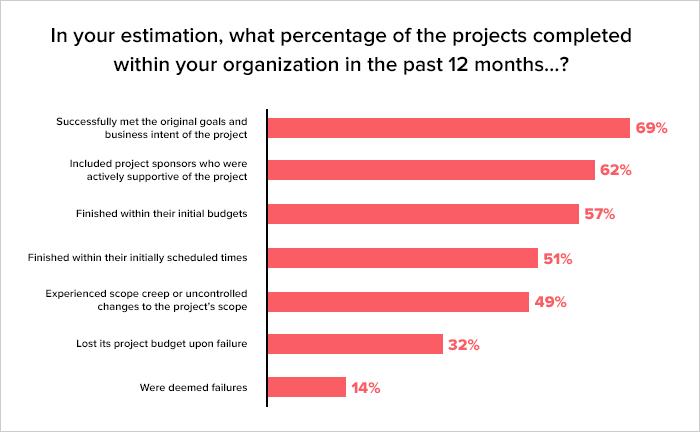Big technology projects fail most of the time. Is there any way to reduce the likelihood of failure? Yes: look at definition, scope and management problems, but don’t look too closely at problems with talent, executive support and corporate culture. They’re nearly impossible to solve.
As I and others have reported, ERP projects routinely fail, and sometimes famously:the Gartner Group reports that 75% of ERP projects fail.Others report that CRM projects fail at nearly the same rate.Big data analytics projects also fail at an alarming rate.Innovation? Clayton Christensen suggested that 95% of product innovation projects fail.Digital transformation fails 70% of the time:McKinsey reports that only 30% of digital transformation projects result in improved corporate performance.There’s failures data everywhere:technology projects fail at an astounding rate at enormous cost to the companies – and executives – who support them.Perhaps the harshest finding is that “90% fail to deliver any measurable ROI.”
Why Are They All Failing So Much?
Why do so many of these big enterprise technology projects fail?3 main reasons:
It’s not because:
Look at the fishbone.It tells us that there are six reasons why enterprise technology projects fail.But the same failures literature that tells us there are six baskets of problems also tells us that the bottom three are the lethal ones.
The 5 Biggest Technology Trends In 2022
‘Enthusiastic Entrepreneurs’: Pre-IPO Statements On Profitability Prove To Be Larger Than Real Life
The 7 Biggest Artificial Intelligence (AI) Trends In 2022
What Does This Mean for Enterprise Project Managers?

Invest as much as you can in the top three – definition, scope and management – problems because the bottom three are essentially unsolvable.Companies can solve their definition, scope and management problems.There are tools, techniques and even “OK” practices that work reasonably well.But the other problems? Unless companies are willing to “refresh” their talent pools (rinse and replace) – which they’re usually unwilling to do – hire smarter executives who understand that project support is far more than a signature on a business case – which they’re equally loathe to do – and change their corporate cultures to truly believe in the short- and long-term power of digital – which they cannot do no matter how hard they try – they’re doomed to repeat their failure histories.This 3-is-better-than-6 approach is all enterprise project managers can pursue.The rest is way, way beyond their pay grades – especially when the project managers themselves should often be rinsed and replaced.
What Else Does It Mean?Think Twice – No, Thrice – About Doing Big Enterprise Projects At All
What other business initiative with a failure rate above 75% be acceptable?Would you proceed with new factory construction if you were 25% likely to succeed?Would you allow residents who fail most of the time to become full-fledged doctors?So why are big technology projects failing all over the place and companies still launching them week after week, month after month, year after year? Why is this happening?
The new failure normal is now officially the technology business, and, for some inexplicable reason, hope always springs eternal.Maybe it’s because the consequences of failure are so small.Or because there’s a sense that the projects must be done no matter what the risks.Or maybe, just maybe, the industry has just learned to accept failure as a feature of all things digital in the early 21st century (much as it was in the late 20th century).Maybe collective expectations are already low.
Race to the Bottom
Must companies transform their processes and even whole business models with technology?They have no choice.The weird outcome here is that the company that fails the least (65% not 75%), wastes the least amount of money (just 80% not 90%), and generates the most impact (from 10% to 15%) “wins.”If ever there was a race to the bottom, this is it.
The business case for a major enterprise technology projects must become the imperfect – but improved – gatekeeper for large investments in digital technology.To win the race to the bottom companies must reinvent their business cases and due diligence processes.They must rethink the objectives, costs and the ROI.They must require least damage analyses.They must develop worst case contingency plans.Public companies must practice failure communications drills designed to downplay spectacular big tech failures. Or just learn how to play small ball.
Small Projects Rule
Incrementalism is good.“Big” projects are far more likely to fail than small ones.While everyone loves a good digital transformation story, they should be resisted until they’ve proven worthy (only after the fact), or reconstituted as big wins in very small packages.Skilled CIOs and CTOs should understand that a huge part of their job is managing expectations downward, or – even smarter, though tougher – setting expectations as low as possible while still generating project excitement.Is this a two-step?Absolutely it is.But how many of us say one thing, but do another?When it comes to big tech project management – given the failure rates – everyone should learn how to dance in slow, small steps, not large ones.Resist the Tango for the Waltz.




